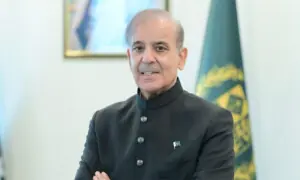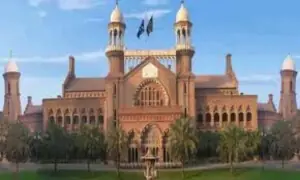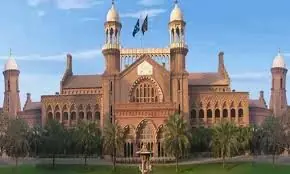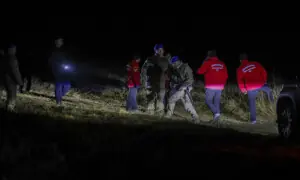As heatwave heads to Larkana, a village tries on cool solutions
With reporting by Sajjad Mehdi in Karachi, and Salamat Abro in Larkana
A friend of mine who works in Khairo Dero, a small village in upper Sindh near Larkana, sent me this photo on her way back to the community centre and free clinic she runs: the car said it was 49 degrees centigrade outside.
“It really is inhuman heat,” she said in a voice note on Monday afternoon accompanied by pictures. “These are two of our field boys, who are out working 10 hours a day. Yesterday they told me the skin on their faces was burning.”

The large handkerchiefs are more than an accessory. The men keep wetting them under groundwater hand pumps and wrapping them around their head to keep from heating up.
Larkana is set to experience scorching temperatures exceeding 50 degrees Celsius in the first week of June, according to meteorological experts.
Dr Sardar Sarfaraz, the chief meteorologist of the Pakistan Meteorological Department, told Aaj News Monday, that Larkana’s weather would be relatively moderate (45°C or lesser) from May 23 to May 26, as a rainfall system is expected to bring drizzle to the region. However, starting from May 27, temperatures are projected to rise, reaching extreme levels by the first week of June.
Aaj News reporter in Larkana Salamat Abro revealed that the blistering heat had discouraged people from leaving home. Marketplaces are deserted between 2pm and 5pm.
Abro highlighted severe power outages plaguing Larkana. Rural areas face up to 10 to 12 hours of load shedding, while urban areas experienced 8 to 9 hours of power cuts.
The story of 2 villages
My friend then told me the story of what has been going on in her village which doesn’t get any electricity.
Starting in April, the weather turns very hot with hot winds. This is the time of the wheat harvest. Interestingly, this year, April was quite a pleasant month. And the wheat crop was harvested in that pleasant weather.
After mid-May, this insane weather that we see at this time of the year, began. The temperatures go up to 49 to 50 degrees centigrade. And they will go up a few more once the rice seedlings are planted and water has been sent into the fields.
In this situation, because it is so incredibly hot, people used to work in the early morning hours from 5am to 10am and then in the evening for a couple of hours. Late morning to late afternoon they stay indoors. As there are no ceiling fans, they use pankhas and drink a very diluted form of a saltish lassi called dudh to cool their insides.

Seven years or so ago, Chinese solar panels started cropping up in the market. As soon as they appeared, my friend’s non-profit trust began a solar project in which 750 families in different villages were given a solar kit (panel, ceiling fan, pedestal fan, small lights and a battery). The battery will last six months to a year and then either the family managed to replace it or didn’t. The project provided people with some relief but was not necessarily a permanent solution.
As the years went on, the Chinese solar panels and fans became more and more affordable. Shops came up with payment installment plans. The kits started to become affordable for (almost) everyone to buy and put up and people started doing this themselves.
Nevertheless, people still had no power at night, and the nights here are oppressively hot. Nobody could afford to constantly replace the solar panel batteries. At the most they could afford one fan. And if there is any decrease in the intensity of the sun, then even that would not work.

This solar light kit is not a replacement for grid electricity which allows high-powered fans, a motor, which many rural families have to pull water from 70 feet below the ground. The groundwater is very cool and a major means of relief. Grid electricity would also allow them to use a motorised chopper for fodder so people don’t have to do that kind of hard labour.
For decades, Khairo Dero had an “arrangement” with the electricity company (once Wapda and now the Sukkur electricity company). Someone was informally appointed both by Wapda and the village community and paid a small stipend of Rs10,000 a month to collect Rs100 or so from every house every month and give it to the Wapda lineman. The Wapda lineman then shares some of those rewards up the line and the kunda connections are allowed to be placed so the village gets power.
In Khairo Dero, that collection mechanism stopped working so the village has had no electricity for more than a year. There were lots of problems: the village is sometimes not able to collect as much as the company wants, sometimes the lines are so weak that they need replacing, a transformer was dismounted and completely ravaged by thieves. So the infrastructure is also hopeless.

Even when the village did have electricity, it ran maybe two or three hours out of 24. If there was an outage for some technical failure, it would last for weeks or months.
My friend’s organisation tried to think of solutions. There are two options. The organisation could set up an entirely separate private solar grid station. It would privately provide electricity to the village’s 500 or so homes. But this would require several crore rupees and a lot for running expenses, manpower, mechanical technical faults, oversight.
The other option that makes more sense is this: There are neighbouring villages that get electricity for a good number of hours a day. The nearest one is Bungaldero which is 2km away from Khairo Dero. That village has a large number of government employees living in it and therefore they are somewhat more organised and influential compared to Khairo Dero, which consists of mostly haris and labourers.
Both Khairo Dero and Bungaldero are majority PPP voters, and my friend doesn’t think there has ever been a time when they have voted for anyone else. There is an influential PPP person in Bungaldero who ensures they have electricity. But because there is no influential PPP person in Khair Dero, they are not able to secure that same line a mere 2km away.
Khairo Dero’s people would not need to install a meter at each house. They could just get organised and if the government met them half-way, they could get access to electricity. My friend’s non-profit could act as the go-between.
“There are solutions but in order to get them implemented both parties have to make an effort and do it consistently,” she said. “The easiest place to start is where a facilitator is available. The government has to be willing to work with us. That can become a model for other villages.”
With reporting by Sajjad Mehdi in Karachi, and Salamat Abro in Larkana
For the latest news, follow us on Twitter @Aaj_Urdu. We are also on Facebook, Instagram and YouTube.

















Comments are closed on this story.